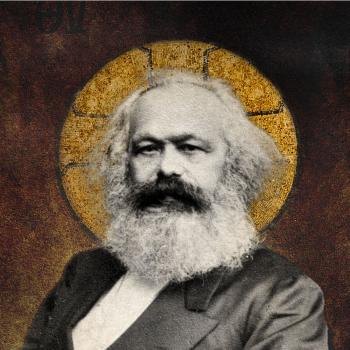A Spanish pilgrim in rough clothes rode on a mule toward Rome and Jerusalem in the year 1522. Ignatius of Loyola was his name. He was “to the manor born” but rejected his wealth and status to pursue spiritual enlightenment. Later he would become the founder of the Jesuit order of Catholic priests.
Along the way he met a Moor – perhaps a man of North African ancestry who converted at least nominally to Christianity to escape persecution after the Catholic conquest of Muslim Spain – and the two of them conversed as they rode side by side down the dusty highway. The conversation focused on the Virgin Mary. The Moor agreed that she had conceived Jesus without a man, but he said that since she delivered Jesus vaginally, she was then no longer a virgin. Ignatius vigorously defended the Catholic dogma that she was still a virgin. The Moor sped up on his mule and left Ignatius behind.
Ignatius stewed about the conversation as the mule slowly carried him forward. He was infuriated at what he perceived to be a mortally serious offense against the Holy Virgin. As a proper caballero, insults against the integrity of a noble lady were not to be taken lightly. Honor had to be defended, at sword-point if necessary. What should he do? The Moor had told him of his destination not far ahead. Should he pursue the Moor and kill him for his disrespect? Or should he let the matter go? He tried to determine the moral basis for a decision, but came up with nothing.
So he decided to let God direct his mule. Perhaps Ignatius was remembering the biblical story of Balaam, whose donkey was more attuned to divine guidance than he was.
He let the reins go slack on the mule just before the fork in the road. One way – the road in better condition – led to the village where the Moor was headed. The other was the bypass road to points east. If God directed the mule to the village, he would defend the Virgin’s honor by slaying the Moor. If God directed the mule to head in the other direction, he would know God intended the matter to be dropped.
The mule carried Ignatius away from that deadly encounter. Were the mule’s big ears better able to hear the voice of God? Or did the mule just smell more grass ahead along the bypass road?
Did this incident explain how the order founded by Ignatius became famous, and even infamous, for its embrace of the wisdom and insights of non-Christian religions?
We all do well to let the reins go slack when we get riled up about religious differences, and let the Love that is God lead us toward peace. Ignatius was emphatic in his belief that the Holy Mother of God was a virgin – before, during, and after the birth of Jesus. That belief mattered to him deeply. Islam reveres Mary, but tells the story of Jesus’ birth and Mary’s status in a different way than is found in the New Testament. It was no wonder that the Moor and the Christian pilgrim had different points of view. It took a mule to convince Ignatius to step away from the conflict long enough to make room in his heart to let the difference be.
As election season begins in earnest, mixing religion and politics in ways that are sometimes combustible, it’s time for a slow, slack ride on Ignatius’ mule – away from anger and toward inquiry, empathy, and appreciation among people of different faiths.
(SIGN UP YOUR CHURCH to participate in PLURALISM SUNDAY – celebrating the diversity of the world’s religions in worship on May 6.)













